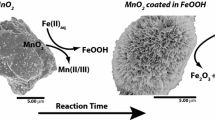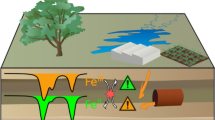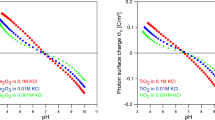Abstract
The effects of reduction and reoxidation of octahedral Fe3+ on the exchange of structural hydrogen in nontronite were determined using tritium (3H) as a label element. The uptake of H from the surrounding solution of nontronite suspensions increased as the reduction of structural Fe3+ increased. Similarly, the loss of H from the structure increased as the reduction increased. The results are generally consistent with a reduction mechanism involving the loss of structural OH, leaving the affected Fe sites with less than six-fold coordination. The attenuation of increased negative charge on the clay layer, however, was less than predicted by such a mechanism.
During the reoxidation of reduced nontronite in suspension, about one-third of the H remaining as part of the structure following reduction was lost, whereas twice that amount of H was incorporated into the structure from the surrounding solution. A reoxidation mechanism is proposed whereby H2O from the surrounding solution is incorporated into the mineral structure followed by the elimination of a hydrogen ion, returning the Fe to six-fold coordination. This mechanism implies the reversibility of Fe reduction in nontronite.
Similar content being viewed by others
References
Addison, W. E. and Sharp, J. H. (1963) Redox behavior of iron in hydroxylated silicates: in Clays and Clay Minerals, Proc. 11th Natl. Conf., Ottawa, Ontario, 1962, Ada Swineford, ed., Pergamon Press, New York, 95–104.
Anderson, W. L. and Stucki, J. W. (1979) Effect of structural Fe2+ on visible absorption spectra of nontronite suspensions: in Proc. Int. Clay Conf., Oxford, 1978, M. M. Mort-land and V. C. Farmer, eds., Elsevier, Amsterdam, 75–83.
Farmer, V. C., Russell, J. D., McHardy, W. J., Newman, A. C. D., Ahlrichs, J. L., and Rimsaite, J. Y. H. (1971) Evidence for loss of protons and octahedral iron from oxidized biotites and vermiculites: Mineral. Mag. 38, 121–137.
Foster, M. D. (1953) Geochemical studies of clay minerals: II. Relation between ionic substitution and swelling in montmorillonite: Amer. Mineral. 38, 994–1006.
Foster, M. D. (1955) The relationship between composition and swelling in clays: in Clays and Clay Minerals, Proc. 3rd Natl. Conf, Houston, Texas, 1954, W. O. Milligan, ed., Natl. Acad. Sci. Natl. Res. Counc. Publ. 395, Washington, D.C., 205–220.
Goodman, B. A., Russell, J. D., Fraser, A. R., and Woodhams, F.W.D. (1976) A Mössbauer and I.R. spectroscopic study of the structure of nontronite: Clays & Clay Minerals 24, 53–59.
Heller-Kallai, L. and Rozenson, I. (1980) Dehydroxylation of dioctahedral phyllosilicates: Clays & Clay Minerals 28, 355–368.
McAuliffe, C. D., Hall, N. S., Dean, L. A., and Hendricks, S. B. (1947) Exchange reactions between phosphates and soils: hydroxylic surfaces of soil minerals: So/7 Sci. Soc. Amer. Proc. 12, 119–123.
O’Neil, J. R. and Kharaka, Y. (1976) Hydrogen and oxygen isotope exchange reactions between clay minerals and water: Geochim. Cosmochim. Acta 40, 241–246.
Radoslovich, E. W. (1962) The cell dimensions and symmetry of layer lattice silicates. II. Regression relations: Amer. Mineral. 47, 617–636.
Ross, G. J. and Rich, C. I. (1973) Changes in b-dimension in relation to potassium exchange and to oxidation of phlog-opite and biotite: Clays & Clay Minerals 21, 201–204.
Roth, C. B., Jackson, M. L., and Syers, J. K. (1969) Deferration effect on structural ferrous-ferric ratio and CEC of vermiculites and soils: Clays & Clay Minerals 17, 253–264.
Roth, C. B. and Tullock, R. J. (1973) Deprotonation of nontronite resulting from chemical reduction of structural ferric iron: in Proc. Int. Clay Conf, Madrid, 1972, J. M. Serratosa, ed., Div. Ciencias C.S.I.C, Madrid, 107–114.
Rouxhet, P. (1970) Kinetics of dehydroxylation and OH-OD exchange in macrocrystalline micas: Amer. Mineral. 55, 841–853.
Roy, D. M. and Roy, R. (1957) Hydrogen-deuterium exchange in clays and problems in the assignment of infrared frequencies in the hydroxyl region: Geochim. Cosmochim. Acta 11, 72–85.
Rozenson, I. and Heller-Kallai, L. (1976) Reduction and oxidation of Fe3+ in dioctahedral smectite 1. Reduction with hydrazine and dithionite: Clays & Clay Minerals 24, 271–282.
Russell, J. D., Farmer, V. C., and Velde, B. (1970) Replacement of OH by OD in layer silicates, identification of the vibrations of those groups in infra-red spectra: Mineral. Mag. 37, 869–879.
Russell, J. D., Goodman, B. A., and Fraser, A. R. (1979) Infrared and Mössbauer studies of reduced nontronites: Clays & Clay Minerals 27, 63–71.
Serratosa, J. M. (1960) Dehydroxylation studies by infrared spectroscopy: Amer. Mineral. 45, 1101–1104.
Stucki, J. W. (1981) The quantitative assay of minerals for Fe2+ and Fe3+ using 1,10-phenanthroline: II. A photochemical method: Soil Sci. Soc. Amer. J. 45, 638–641.
Stucki, J. W. and Anderson, W. L. (1981) The quantitative assay of minerals for Fe2+ and Fe3+ using 1,10-phenanthroline: I. Sources of variability: Soil Sci. Soc. Amer. J. 45, 633–637.
Stucki, J. W., Golden, D. C., and Roth, C. B. (1984a) The preparation and handling of dithionite-reduced smectite suspensions: Clays & Clay Minerals 32, 191–197.
Stucki, J. W., Golden, D.C., and Roth, C.B. (1984b) Effects of reduction and reoxidation of structural iron on the surface charge and the dissolution of dioctahedral smectites: Clays & Clay Minerals 32, 350–356.
Stucki, J. W., Low, P. F., Roth, C. B., and Golden, D. C. (1984c) Effects of oxidation state of octahedral iron on clay swelling: Clays & Clay Minerals 32, 357–362.
Stucki, J. W. and Roth, C. B. (1976) Interpretation of infrared spectra of oxidized and reduced nontronite: Clays & Clay Minerals 24, 293–296.
Stucki, J. W. and Roth, C. B. (1977) Oxidation-reduction mechanism for structural iron in nontronite: Soil Sci. Soc. Amer. J. 41, 808–814.
Vedder, W. and Wilkins, R. W. T. (1969) Dehydroxylation and rehydroxylation, oxidation and reduction of micas: Amer. Mineral. 54, 482–509.
Author information
Authors and Affiliations
Rights and permissions
About this article
Cite this article
Lear, P.R., Stucki, J.W. Role of Structural Hydrogen in the Reduction and Reoxidation of Iron in Nontronite. Clays Clay Miner. 33, 539–545 (1985). https://doi.org/10.1346/CCMN.1985.0330609
Received:
Accepted:
Published:
Issue Date:
DOI: https://doi.org/10.1346/CCMN.1985.0330609




